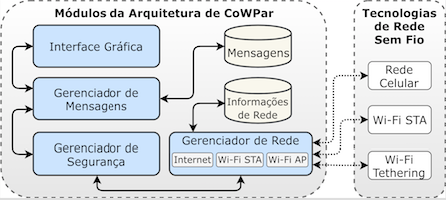CoWPar: A D2D Communication Approach Without Pairing for Mobile Social Network in Proximity
DOI:
https://doi.org/10.22456/2175-2745.79152Keywords:
Device-to-Device Communication, Wi-Fi Tethering, Mobile Social Network, Pervasive ComputingAbstract
Mobile devices and the cellular network have been popularized and evolving in recent years. The increase of these devices may promote Device-to-Device (D2D) communications. However, current D2D communication technologies such as Wi-Fi Direct, Wi-Fi Ad Hoc, and Bluetooth are not available on devices or require human interaction in the pairing process. In addition, the cellular network is not available in many places and has partial or total communication infrastructure failures. To overcome this failure and lack of connectivity, and to allow D2D communication between devices in disturbing scenarios, we presented CoWPar. Based on the Wi-Fi infrastructure mode, CoWPar establishes the connection and performs data exchange without human interaction between the devices. Results of experiments performed in a proof of concept showed in practice that CoWPar allowed D2D communications with no pairing and also without the need to change the operating system (OS) of the devices, surpassing all the works available so far and thus contributing to the process of viabilization the paradigm of Pervasive Computing.
Downloads
References
ARMINEN, I. New reasons for mobile communication: Intensification of time-space geography in the mobile era. In: The Reconstruction of Space and Time. New York, Usa: Routledge, 2017. v. 1, cap. 4, p. 89–107.
ZHANG, X. et al. Incentives for mobile crowd sensing: A survey. IEEE Commun. Surv. Tutor., v. 18, n. 1, p. 54–67, 2016.
PAVONE, M. Autonomous mobility-on-demand systems for future urban mobility. In: MAURER, M. et al. (Ed.). Autonomous Driving. Berlin, Germany: Springer Berlin Heidelberg, 2016. v. 1, p. 387–404.
EBLING, M. R. Pervasive computing and the internet of things. IEEE Pervasive Comput., v. 15, n. 1, p. 2–4, 2016.
MAO, Z. et al. Mobile social networks: Design requirements, architecture, and state-of-the-art technology. Comput. Commun., v. 100, n. 1, p. 1–19, 2017.
DAHLMAN, E.; PARKVALL, S.; SKOLD, J. 4G, LTE-advanced Pro and the Road to 5G. 3. ed. Cambridge, Usa: Academic Press, 2016. v. 1.
OPENSIGNAL, I. Global State of Mobile Networks (February 2017). [S.l.], 2017.
NETWORK, E. U. A. for; (ENISA), I. S. Analysis of Article 13a annual incident reports in the telecom sector, Crete, Greece. Crete, Greece: ENISA, 2017. v. 1.
GEBHART, G.; KOHNO, T. Internet censorship in thailand: User practices and potential threats. In: SABELFELD, A.; SMITH, M. (Ed.). IEEE European Symposium on Security and Privacy. Paris, France: IEEE, 2017. v. 1.
NEOKOSMIDIS, I. et al. Assessment of socio-techno- economic factors affecting the market adoption and evolution of 5g networks: Evidence from the 5g-ppp charisma project. Telematics Inform., v. 34, n. 5, p. 572–589, 2017.
SINGH, S. et al. A survey on 5g network technologies from social perspective. IETE Tech. Rev., v. 34, n. 1, p. 30–39, 2017.
WANG, Y. et al. Device-to-device based mobile social networking in proximity (msnp) on smartphones: Framework, challenges and prototype. Future Gener. Comput. Syst., v. 74, n. 1, p. 241–253, 2017.
HO, Q.-D.; TWEED, D.; LE-NGOC, T. Ieee 802.11/wi-fi medium access control: An overview. In: Long Term Evolution in Unlicensed Bands. 1. ed. Berlin, Germany: Springer, 2017, (BRIEFSELECTRIC, ’17). p. 31–41.
ZUO, J. et al. Hychat: A hybrid interactive chat system for mobile social networking in proximity. In: YAU, S. S.; DEEN, J.; WU, X. (Ed.). Smart City/SocialCom/SustainCom (SmartCity), 2015 IEEE International Conference on. Chengdu, China: IEEE, 2015. v. 1, p. 471–477.
ARNABOLDI, V.; CONTI, M.; DELMASTRO, F. Cameo: A novel context-aware middleware for opportunistic mobile social networks. Pervasive Mob. Comput., v. 11, n. 1, p. 148–167, 2014.
(TG1), W. task group . IEEE Std 802.15.1 - Part 15.1: Wireless Medium Access Control (MAC) and Physical Layer (PHY) Specifications for Wireless Personal Area Networks (WPANs). [S.l.], 2017.
ALAMI, M. E. et al. A framework for hotspot support using wi-fi direct based device-to-device links. In: MAURI, J. L. (Ed.). Wireless Communications and Mobile Computing Conference (IWCMC), 2017 13th International. Valencia, Spain: IEEE, 2017. v. 1, p. 552–557.
ALLIANCE, W.-F. Wi-Fi Peer-to-Peer (P2P) Technical Specification, Version 1.7. [S.l.], 2016.
DOUFEXI, A. et al. Hotspot wireless lans to enhance the performance of 3g and beyond cellular networks. IEEE Commun. Mag., v. 41, n. 7, p. 58–65, 2003.
CONSTANTINESCU, M. et al. Mobile tethering: overview, perspectives and challengess. Info, v. 16, n. 3, p. 40–53, 2014.
SCHULZ, S. et al. Tetherway: A framework for tethering camouflage. In: KRUNZ, M.; LAZOS, L. (Ed.). Proceedings of the Fifth ACM Conference on Security and Privacy in Wireless and Mobile Networks. New York, NY, USA: ACM, 2012. (WISEC, ’12), p. 149–160.
NORDSTRO ̈M,E.;ROHNER,C.;GUNNINGBERG,P. Haggle: Opportunistic mobile content sharing using search. Comput. Commun., v. 48, n. 1, p. 121–132, 2014.
DUBOIS, D. J. et al. Shair: Extensible middleware for mobile peer-to-peer resource sharing. In: MEYER, B. (Ed.). Proceedings of the 2013 9th Joint Meeting on Foundations of Software Engineering. New York, USA: ACM, 2013. (ESEC/FSE 2013, v. 9).
BUJARI, A.; MIOTTO, N. Nudge nudge: A proximity based social application. In: Wireless Days (WD), 2011 IFIP. Niagara Falls, Canada: IEEE, 2011. v. 1.















